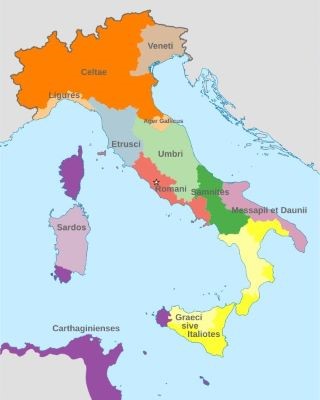The Enemies of Rome in the Early Republic
Talk the Talk
The Republic of ancient Rome can be divided into three stages, the Early, Mid and Late Republic.
The Early Republic began in approximately 509 BCE, and during this period, distinguishing fact from fiction is often a challenging task as reliable sources are scarce.
Historians such as Titus Livius (commonly known as Livy) often invented speeches to portray both sides of an argument, and much of the rest of the histories written at the time were also embellished or outright fictional.
However, by the time of the Mid-Republic (c.290 – 88 BCE) and into the Late Republic (c.88 – 31 BCE), there is far more verifiable history, largely thanks to contemporary historians who strove to provide accurate accounts of important people and events from the periods in which they lived.
Walk the Walk
During the Third Samnite War, the Roman army fought against a coalition of enemies that included the Samnites, Gauls, Umbrians, and Etruscans.
The night before the Battle of Sentinum in 295 BCE,
the Roman general and consul Decius Mus had a dream in which Rome would win the battle, but only if one of the two consuls present were to die.
The next day, the Romans faced possible defeat, so
to fulfil his prophetic dream, Decius charged his horse directly into the enemy’s lines. This ultimately led to his death (depicted below), but it inspired his troops so much that they turned the
tide and secured a resounding victory.
Roman Quote
They themselves say that their founders were brought up by the milk of a she-wolf; just so that the entire race has hearts of wolves, insatiable for blood and ever greedy and lusting after power and riches.
~ Mithridates of Pontus ~
 The first enemy of ancient Rome during the Early Republic era (c.500 BCE – c.290 BCE) was the city-state’s last king, Tarquinius Superbus (R. 535 – 509 BCE). Many people were unhappy with his tyrannical rule and when a noblewoman, Lucretia, was raped by Tarquinius’ son Sextus, it was seen as the final straw. It prompted a group of Senators, led by the king’s nephew Lucius Junius Brutus, to usurp Tarquinius and send him and Sextus into exile. This ended the Period of Kings in ancient Rome and saw the foundation of the Roman Republic.
The first enemy of ancient Rome during the Early Republic era (c.500 BCE – c.290 BCE) was the city-state’s last king, Tarquinius Superbus (R. 535 – 509 BCE). Many people were unhappy with his tyrannical rule and when a noblewoman, Lucretia, was raped by Tarquinius’ son Sextus, it was seen as the final straw. It prompted a group of Senators, led by the king’s nephew Lucius Junius Brutus, to usurp Tarquinius and send him and Sextus into exile. This ended the Period of Kings in ancient Rome and saw the foundation of the Roman Republic. Tarquinius began plotting his return, but the plan was discovered and those who aided the former king were executed, including two of Brutus’ own sons. Soon after, Tarquinius gathered a force of his native Etruscans and attacked the Roman army at the Battle of Silva Arsia. Brutus was killed in the fray by the second son of the former king, Arruns Tarquinius, when they fatally impaled each other with spears. However, ultimately the Romans prevailed, and the Etruscans fled the battlefield. Tarquinius then turned to Lars Porsena, the king of Clusium, who had attacked the Roman gates and may have even held the city for a short while, but this ultimately was of no help to the usurped Roman king. Finally, Tarquinius turned to his son-in-law Octavius Mamilius, dictator of the Latin tribe of Tusculum however, after another hard-fought conflict at the Battle of Lake Regillus (499 or 496 BCE), the Romans were victorious. Tarquinius Superbus died in 495 BCE while still in exile and Rome would never again be ruled by a king.
Expansion in the Early Republic
The Battle of Lake Regillus, triggered the First Latin War, which was fought between the Roman Republic and an alliance of around thirty villages and tribes that were situated near Rome in Central Western Italy and are commonly referred to as the Latin League.
Although sharing a language and many other cultural traits, these communities would often be Rome's enemies during the early Republic. This conflict raged on until 493 BCE when the Roman consul Spurius Cassius Vecellinus agreed to a treaty with the Latins, assuring mutual defence between the two peoples.
Between 437 and 426 BCE, Rome was engaged in a war with Fidenae, a town situated upstream of the city, which, despite having an organised and strong army, was soon defeated and its lands added to the Roman sphere of influence. The next major conflict was fought against the Etruscan city of Veii and is said to have lasted ten years (406 – 396 BCE). With victory, Roman territory increased by eighty-four per cent and allowed for further conquest and alliances with the lands beyond Fidenae and Veii.
The Gauls were a group of Celtic people who originally came from modern-day France and by around 450 BCE, had relocated to Italy. In ancient Rome, the Gallic tribesmen were considered barbarians because they lacked a written language and did not construct cities. However, in c.390 BCE, they attacked and defeated Rome at the Battle of the Allia River, sacking and briefly occupying the city. This caused many of its citizens to flee, and the invading Gauls only agreed to leave after a hefty ransom was paid in gold. After this, the Romans had more respect for the Celts in Italy, although they still considered them barbarians.
This left the city-state weak and open to attack from other neighbouring communities and the years that followed would be tumultuous. As the Roman Republic fought and won in battles with neighbouring tribes, they gained territory and their political power increased, so much so that by 358 BCE, they were in a position to renegotiate the treaty they had with the Latin League, this time making sure it favoured the Romans more than it did the Latins.
The First Samnite War
The Samnites were originally a group of tribes that had no political unification but coexisted along the central and southern Apennine Mountains. However, with an ever-expanding Rome as a neighbouring state, the tribes would unite making them a formidable enemy of Rome and potentially strong enough to challenge for dominance in the area.
Throughout three conflicts known as the Samnite Wars, the hardened soldiers and rugged terrain proved challenging for the Roman army, forcing it to transform its military strategies in ways that would later aid in conquering not only the Italian Peninsula but also the wider Mediterranean region.
The First Samnite War lasted from 343 to 341 BCE and may have originated when the Campanians asked Rome to ally with them against the Samnites to settle old scores. If this is the case, it would be the first of many times that Rome would get involved in a war by allying with a weaker state and overthrowing their enemy. Rome would then absorb the ally along with the vanquished opponent, and as is probably the case with Campania, its citizens would be granted civitas sine suffragio (citizenship without the right to vote in Rome).
The Second Latin War
According to the Roman historian Livy, after the First Samnite War ended, the Latin League launched a series of raids on the Samnites, prompting them to appeal to Rome, which had treaties with both factions. When Roman senators tried to order the Latins to cease their attacks pointing out that the gods themselves acted as witnesses to official treaties, the Latin League’s envoy, Praetor Lucius Annius, argued that his people were not subjects of Rome but allies and therefore were not required to follow the commands of the Senate.
He was then heard being disrespectful to the divine power of the supreme god of Rome, Jupiter, as he stormed out of the deity’s own temple. As he did, he slipped on the steps of the place of worship which resulted either in his death or in him being rendered unconscious. Upon seeing this, the Roman consul Titus Manlius Torquatus declared it a celestial sign and vowed to strike down the Latin armies, just as Jupiter had struck down Annius.
Most modern historians doubt the validity of this version of events. The general consensus is that the Second Latin War was a response to the aggressive nature of an ever-growing Roman state by smaller Latin communities, which were determined not to be forced to come under Rome's influence, preferring instead to remain independent.
The war itself lasted from 340 to 338 BCE and ultimately ended with the dissolution of the Latin League. The tribal lands and villages that had made up the League’s territory were now considered to be a part of the Roman sphere of influence meaning the war actually led to what the non-Roman Latins had feared the most.
The people who lived on these lands were granted varying levels of citizenship, although the towns maintained their own governments, which were allowed to rule on many local matters. They also retained their legal rights as they had previously, which became known as ius Latii (Latin Rights), a system that would be used frequently over the coming centuries as a transitional step for conquered people to transition from being non-Roman to attaining full citizenship. While Rome’s territories were increasing, at this time they still only had dominion over a relatively small portion of Italy (see map above).
The Second Samnite War
The Roman Republic now controlled most of Central Western Italy and over the next ten years continued to push its frontiers, annexing smaller territories either by conquest or colonisation. This would ultimately bring them into conflict with the Samnites of the middle Liris (modern Liri) River valley, leading to the Second Samnite War (326 – 304 BCE).
Early in the Great Samnite War as it is also known, the Roman army suffered several significant defeats. In 321 BCE, a Roman force was trapped by the Samnites in a narrow canyon near the Caudine Forks which forced them to surrender and sign a five-year non-aggression treaty.
In 315 BCE after the resumption of hostilities, they suffered another humiliating loss at Lautulae. Here, the Samnites employed a manipular system, whereby their soldiers were organised into groups separated by large, empty spaces. Compared to the hoplite tactics used by the Romans, which had them in a single solid mass of men, the manipular system allowed for much better flexibility and manoeuvrability, especially on the rugged terrain they were fighting on.
After this, the Romans adopted the tactic for themselves and used it throughout the remainder of the Republic era and into the Roman Empire era.
In the coming years, Rome began to develop a navy, constructed its first roads that facilitated the movement of soldiers and equipment with greater efficiency, and increased the annual military budget.
As a result, the tide of the Second Samnite War began to turn in Rome’s favour as they took control of much of Samnite territory. In the final phase of the war, they also managed to extend their influence into Northern Etruria and Umbria. In 306 BCE, they signed a treaty with Carthage that acknowledged all of Italy as part of the Roman sphere of influence.
The Romans won a decisive battle in 305 BCE when the two consuls, Lucius Postumius Megellus and Titus Minucius Augurinus, marched on the region of Samnium. Minucius engaged the enemy forces first and after the battle had raged on for hours, Postumius joined in with his fresh men and slaughtered the enemy. The following year, the Samnites sent representatives to Rome to negotiate peace and according to Livy, the ancient treaty between the Romans and the Samnites was restored.
The Third Samnite War
The Third and last of the Samnite Wars was fought from 298 to 290 BCE. Previously, unrest had been prevalent in the area, and several city-states were forming alliances with one another to defend against their common enemies.
In 298 BCE, the Samnites invaded Lucania, who promptly asked the Romans for help, which they agreed to provide. War was declared, though the actual reason is debated. Some believe it is as it seems and a direct result of coming to the aid of an ally. Others suggest, however, that Rome deliberately sought war with the Samnites by allying with their enemies, as they feared the Samnites would become too strong with the subjugation of the Lucanians, along with various alliances they were forming.
From 297 BCE, the Roman army attacked Samnium, pushing deeper and deeper into their countryside over the following year, until the Samnite army was forced outside its own territory. They then turned their attention to the major cities and in 296 BCE, seized Murgantia, Romulea and Ferentium.
This prompted the Samnites to successfully appeal to their Etruscan neighbours for support which was soon followed by the Umbrian tribes and the Gauls joining the alliance. After several battles and skirmishes, the most decisive clash of the Third Samnite War was fought in 295 BCE and is known as the Battle of Sentinum (depicted below).
The two forces were evenly matched for much of the conflict, but by the end of a hard-fought battle, the Romans emerged victorious, having lost around 8,700 men, while the Samnites and their allies had lost around 20,000 troops.
This emphatic defeat was a turning point in the final Samnite War as it not only significantly reduced the number of fighting men the Samnites had, but it also broke up the alliances they had with the Gauls, the Etruscans and the Umbrians. Despite this, the Samnites fought on for five years, but were mostly limited to guerrilla tactics and skirmishes. It was not until 290 BCE that they finally capitulated.
The Roman Republic now controlled most of the Italian peninsula and with the end of the Samnite Wars also came the end of what modern historians have dubbed the Early Republic.
The next era, known as the Middle Republic (290 – 88 BCE), would witness many more battles for the Roman state, culminating in its emergence as one of the most powerful nations the ancient world
had ever known.
Written by Andrew Griffiths – Last updated 24/09/2025. If you like
what you see, consider following the History of Fighting on social media.
Further Reading:
Badian, E. et al. [Internet]. 2008. Ancient Rome. Encyclopaedia Britannica. Available From:
www.britannica.com/place/ancient-Rome [Accessed 28 July 2025].
Conliffe, C. [Internet]. 2018. Tarquin the Proud, Last King of Rome. HeadStuff. Available From:
www.headstuff.org/culture/history/terrible-people-from-history/tarquin-the-proud-last-king-of-rome
[Accessed 28 July 2025].
Samnites. [Internet]. 2021. The History Files. Available From:
www.historyfiles.co.uk/KingListsEurope/ItalySamnites.htm
[Accessed 28 July 2025].
Your Guide to the Roman Republic. [Internet]. 2020. History Extra. Available From:
www.historyextra.com/period/roman/roman-republic-guide-how-senate-plebeians-citizenship-women-democratic-fall-end
[Accessed 28 July 2025].
More Roman History
Roman Army History Home
A look at the weapons, tactics and organisation of the armies of ancient Rome and how they evolved from a small civil militia in the seventh century BCE in to the most formidable fighting force in the known world by the first century BCE and eventually saw the fall of the Roman Empire by the fifth century CE.
A look at the weapons, tactics and organisation of the armies of ancient Rome and how they evolved from a small civil militia in the seventh century BCE in to the most formidable fighting force in the known world by the first century BCE and eventually saw the fall of the Roman Empire by the fifth century CE.

The Period of Kings in Ancient Rome
A look at the early history of ancient Rome, commonly known as the Period of Kings. While much of this period in Rome’s history is steeped in myth and legend, it is clear that it began to expand soon after its conception. Its population and territories grew under a series of kings who worked in tandem with an elected senate.
The Roman Republic
The Roman Republic era spanned nearly five hundred years from around 509 – 31 BCE and was a time of great expansion and innovation. The foundation of Roman law was laid, infrastructure was greatly improved, the Roman army went from being a local militia to one of the most formidable professional armies the world had ever seen and the territories of ancient Rome grew exponentially.
The Roman Republic era spanned nearly five hundred years from around 509 – 31 BCE and was a time of great expansion and innovation. The foundation of Roman law was laid, infrastructure was greatly improved, the Roman army went from being a local militia to one of the most formidable professional armies the world had ever seen and the territories of ancient Rome grew exponentially.
The images on this site are believed to be in the public domain, however, if any mistakes have been made and your copyright or intellectual rights have been breeched, please contact andrew@articlesonhistory.com.




